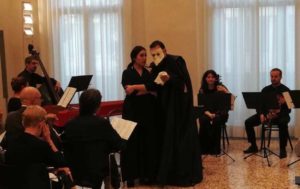
Vicenza In Lirica Festival 2019 Review: Bacocco e Serpilla
Orlandini’s Intermezzi Delight The Audience
By Alan NeilsonWith the development of of opera seria at the beginning of the 18th century, the comedic scenes so typical of 17th century Venetian opera lost their standing; lacking the seriousness and dignity of antiquity they were considered inappropriate to the classical tradition and abandoned.
This in turn led to the rise of the intermezzo, a short comedy piece in two or three parts performed in between the acts of the main opera, comprising two, sometimes three characters. The plot was simple, light and amusing and made use of disguises, misunderstandings and characters from the lower orders of society, far removed from the refined elegance and ideals of opera seria.
It was, however, to prove a short-lived form, lasting no more than 50 years, when it transformed into opera buffa. As part of the Vicenza in Lirica 2019 festival a presentation “Bacocco e Serpilla” or “Il marito giocatore e la moglia bacchettone” was given in the Gallerie d’Italia – Palazzo Leoni Montanari.
From Loss To Love
Written by the Florentine composer Giuseppe Maria Orlandini (1676 – 1760) to a libretto by Antonio Salvi, and premiered at Teatro S. Angelo, Venice in 1718, it is a tale of the domestic tribulations of the gambler, Bacocco, and his wife, Serpilla. In Part one we are introduced to Bacocco who has lost everything, and is running scared of his wife, who chastises him at every turn. During Part two, Serpilla visits a judge to get protection.
The judge, however, is Bacocco in disguise, who makes advances to Serpilla. Serpilla responds and Bacocco reveals himself and drives her out. In Part three, Serpilla is living in poverty, but their love has not died and in a happy ending they are eventually reunited.
The performance took place in a small room, with enough seating for about 100 to 150 people. The chamber orchestra and two singers played out the story positioned in front of the windows at the end of the room. There were no props, but full use was made of the space, with Bacocco hiding beneath the harpsichord or escaping through a side door in an attempt to escape Serpilla’s wrath.
Costumes were basic, consisting no more than present day dark clothing, with a mask to hide Bacocco’s face or cloak to keep Serpilla warm. Direction and design were by Cesare Scarton and Eva Hribernik, who did an excellent job in keeping the drama moving at a fast pace, and coaxing convincing acting performances from the singers.
Two Young Lovers
Barocco and Serpilla were played by two young singers: baritone, Michele Perrella and mezzo-soprano, Antonella Carpenito. Neither role is technically very demanding, but both singers made the most of the opportunity, and acquitted themselves well. Injecting their performances with an emotional intensity and honesty which brought life to their characters, they ensured the audience was able to fully engaged with the drama.
Perrella sang with a confident swagger. His Bacocco was not open to a lot of self-reflection, but was certainly keen to vent his emotions. Perrella has a strong, well-focused voice, and expresses himself clearly. He crafted his recitatives with an intelligence which displayed a secure understanding of the text. His acting was equally well defined, and made excellent use of facial expressions to reveal his outrage, anger, fear or love.
Carpenito’s voice has a warm, colourful timbre, with a pleasing middle register. Like Perrella, she paid careful attention to the delivery of the recitatives, contouring her lines with expressive emphases, and making full use of the voice’s flexibility. Her acting ability was also to a high standard, enabling her to produce a convincing portrayal of the bossy or, depending upon how one views Bacocco’s behaviour, put upon wife.
Each part ends with a duet. In each case Perrella and Carpenito combined well, displaying a sympathetic understanding for each other’s role. The second duet, “Quest’è quell uomo” was particularly strong, in which Perrella caught Bococco’s overstated anger and outrage, which contrasted splendidly with Carpenito’s heartfelt pleading. Underlying their posturing, their deeper feelings of mutual love and affection occasionally shone through in what was a nuanced performance.
Under the direction of Donatella Busetto on the harpsichord, the Ensemble Cenacolo Musicale di Barocco Europeo gave a spirited and engaging account of the score, which included three well-chosen introductions, (one for each part), by the 18th century composer, Pietro Locatelli.
The entire performance lasted approximately one hour, and was an ideal way to pass a late Sunday afternoon before the evening opera, “La Diavolessa” by Baldassare Galuppi. Holding it in a gallery gave the work an intimacy that is lost even in the smallest of theatres, which allowed one to be up close to the singers, making it a very personal and direct experience. The fact that Orlandini’s intermezzo was musically and dramatically strong, that the singers were so emotionally engaged and that the audience was so clearly enthusiastic made for an absorbing and enjoyable occasion.



